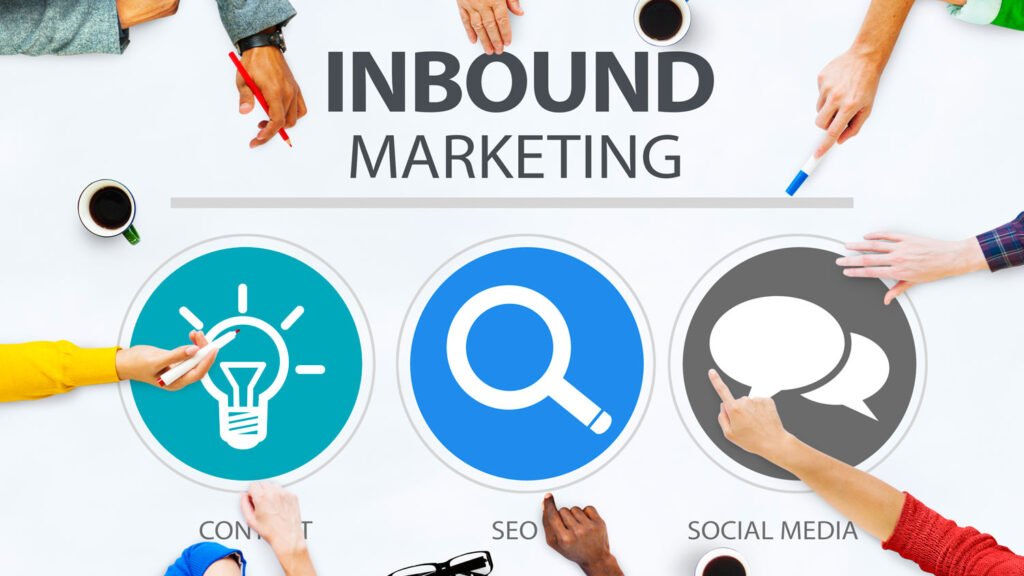Today traditional marketing strategies are no longer as effective as they once were. Consumers are becoming increasingly adept at blocking out interruptive advertisements and are seeking out information on their own terms. This shift in consumer behavior has led to the rise of inbound marketing – a methodology focused on attracting, engaging, and delighting customers through relevant and valuable content.
What exactly is inbound marketing, and how does it differ from outbound marketing? In this comprehensive guide, we’ll delve into the fundamentals of inbound marketing, its key components, and how businesses can leverage this approach to drive growth and build lasting relationships with their audience.
What is Inbound Marketing?
Inbound marketing is a customer-centric approach that aims to attract and retain customers by creating and distributing valuable content tailored to their needs and interests. Unlike outbound marketing, which relies on interruptive tactics like cold calling and advertising, inbound marketing focuses on providing helpful information that aligns with the customer’s journey.
By harnessing the power of data-driven insights, businesses can tailor their marketing efforts to deliver highly personalized experiences that resonate with their target audience. From predictive analytics that anticipate consumer needs to AI-powered chatbots that provide instant assistance, inbound marketing allows companies to stay one step ahead of the competition. Moreover, the dynamic nature of inbound marketing enables businesses to adapt their strategies in real time, ensuring that they remain relevant and responsive to changing market trends and consumer demands.
Beyond its technical prowess, inbound marketing fosters authentic connections between businesses and their customers by prioritizing meaningful interactions over traditional advertising tactics. Rather than bombarding consumers with intrusive ads, inbound marketing focuses on delivering valuable content that educates, entertains, and inspires. Whether through engaging blog posts, informative videos, or interactive social media campaigns, businesses have the opportunity to build trust, loyalty, and brand advocacy among their audience.
Inbound marketing represents a holistic approach to customer engagement that goes beyond mere transactional relationships. By placing the customer at the center of their marketing efforts, businesses can create meaningful connections that drive long-term success and sustainability. In today’s hyper-connected world, where consumers have more choices and higher expectations than ever before, embracing inbound marketing is essential for businesses looking to thrive in the digital age.
Key Components of Inbound Marketing:
1. Content Creation:
At the heart of inbound marketing is content creation. Content creation serves as the cornerstone of inbound marketing, embodying its essence and driving its effectiveness. Through a strategic and thoughtful approach, businesses craft various forms of content such as informative blogs, engaging videos, compelling social media posts, insightful eBooks, and more. The primary objective is to resonate with the needs, challenges, and interests of the target audience. By addressing their pain points and providing valuable solutions, businesses establish themselves as authoritative sources within their respective industries. Quality content not only attracts attention but also cultivates trust and credibility among consumers, laying the foundation for meaningful and lasting relationships. In essence, content creation is the fuel that powers the inbound marketing engine, fueling engagement, nurturing leads, and ultimately driving business growth.
2. SEO (Search Engine Optimization):
SEO, or Search Engine Optimization, plays a pivotal role in the success of inbound marketing efforts. It involves a strategic approach to optimizing website content and structure to rank higher in search engine results, thereby increasing visibility and attracting organic traffic. The process begins with thorough keyword research to identify terms and phrases that potential customers are likely to use when searching for products or services related to your business. By strategically incorporating these keywords into website content, including headings, body text, and meta tags, businesses can signal relevance to search engines and improve their chances of ranking for relevant searches.
Moreover, optimizing meta tags, including title tags and meta descriptions, allows businesses to provide concise and compelling summaries of their content, encouraging users to click through to their website from the search results page. Additionally, creating high-quality content that is informative, engaging, and valuable to the target audience not only satisfies user intent but also increases the likelihood of earning backlinks from other reputable websites—a key factor in search engine rankings.
Ultimately, effective SEO strategies not only enhance a website’s visibility in search engine results pages (SERPs) but also improve user experience and drive organic traffic, thereby supporting the overarching goals of inbound marketing—attraction, engagement, and conversion. By aligning SEO efforts with content creation and user experience optimization, businesses can maximize their online presence and achieve sustainable growth in the digital landscape.
3. Social Media Marketing:
Social media marketing is a vital component of inbound marketing, leveraging the power of various platforms to foster meaningful interactions and build relationships with the target audience. These platforms, including Facebook, Twitter, LinkedIn, and Instagram, offer businesses an unparalleled opportunity to engage directly with their customers, share valuable content, and showcase their brand personality.
By establishing a robust presence on social media, businesses can amplify their reach and visibility, effectively extending their brand’s influence to a wider audience. Through regular updates, engaging posts, and interactive content, businesses can cultivate a loyal following and foster authentic connections with potential customers. Social media also serves as a platform for customer feedback, allowing businesses to gain valuable insights into consumer preferences, opinions, and concerns.
Furthermore, social media provides a dynamic environment for sharing valuable content and driving traffic to your website or other digital assets. Whether it’s sharing blog posts, videos, infographics, or promotions, businesses can leverage social media to disseminate content that resonates with their audience and encourages engagement.
Social media marketing is about more than just broadcasting messages—it’s about fostering two-way communication, building trust, and nurturing relationships. By embracing social media as a key component of their inbound marketing strategy, businesses can tap into a vast and engaged audience, driving brand awareness, customer loyalty, and ultimately, business growth.
4. Email Marketing:
Email marketing stands as a fundamental pillar of inbound marketing, enabling businesses to nurture leads, maintain regular communication, and cultivate lasting relationships with their audience. Through targeted and personalized email campaigns, businesses can deliver valuable content, promotions, and updates directly to their subscribers’ inboxes, ensuring that their brand remains top-of-mind.
One of the key advantages of email marketing is its ability to deliver highly relevant and tailored messages to segmented audiences. By leveraging data such as demographics, past purchase behavior, and engagement metrics, businesses can create targeted email campaigns that resonate with the unique interests and preferences of their subscribers. Whether it’s sharing informative blog posts, exclusive offers, or product updates, email marketing allows businesses to provide value to their audience while also driving engagement and fostering brand loyalty.
Furthermore, email marketing serves as a powerful tool for lead nurturing, guiding potential customers through the sales funnel and converting them into paying customers. By delivering timely and relevant content at each stage of the buyer’s journey, businesses can address their audience’s needs and concerns, build trust, and ultimately drive conversions.
Moreover, email marketing offers unparalleled opportunities for measuring and optimizing campaign performance. Through detailed analytics, businesses can track metrics such as open rates, click-through rates, and conversion rates, gaining valuable insights into the effectiveness of their email campaigns and identifying areas for improvement.
Email marketing remains an indispensable component of inbound marketing strategies, allowing businesses to nurture leads, maintain engagement, and drive conversions effectively. By delivering targeted, personalized, and valuable content directly to their audience’s inbox, businesses can build stronger relationships, drive brand loyalty, and ultimately achieve their marketing objectives.
5. Landing Pages and Lead Magnets:
Landing pages and lead magnets play a crucial role in the success of inbound marketing strategies, serving as powerful tools for capturing visitor information and nurturing leads through the sales funnel.
Landing pages are standalone web pages designed with a specific purpose—to capture visitor information in exchange for valuable content or offers. Unlike traditional website pages, landing pages are optimized for conversion, with minimal distractions and a clear call-to-action (CTA) that prompts visitors to take a desired action, such as signing up for a newsletter, downloading an eBook, or registering for a webinar.
Lead magnets are incentives offered to visitors in exchange for their contact information. These incentives, which can take the form of eBooks, whitepapers, webinars, or exclusive offers, are designed to provide value and address the needs or pain points of the target audience. By offering valuable content or resources, businesses entice visitors to provide their email addresses or other contact details, allowing them to initiate contact and nurture leads further down the sales funnel.
Together, landing pages and lead magnets enable businesses to capture valuable prospect information and begin building relationships with potential customers. Once a visitor has provided their contact information, businesses can use email marketing and other tactics to deliver personalized content, nurture leads, and guide them through the buying process.
Landing pages and lead magnets are essential components of inbound marketing strategies, providing a means to capture visitor information and initiate the lead nurturing process. By offering valuable content and resources in exchange for contact details, businesses can attract, engage, and convert prospects, ultimately driving growth and achieving their marketing goals.
6. Marketing Automation:
Marketing automation stands as a transformative component within inbound marketing strategies, empowering businesses to streamline and automate repetitive tasks across various marketing channels. From email campaigns and lead nurturing to social media posting and customer segmentation, marketing automation tools offer a plethora of functionalities aimed at optimizing efficiency and enhancing customer engagement.
One of the primary benefits of marketing automation is its ability to save time and resources by automating manual tasks. Rather than manually sending individual emails or social media posts, businesses can set up automated workflows that trigger based on specific criteria, such as user behavior or demographic information. This allows businesses to maintain consistent communication with their audience without the need for constant manual intervention.
Moreover, marketing automation enables businesses to deliver personalized experiences at scale. By leveraging data and segmentation capabilities, businesses can tailor their messaging to individual preferences, interests, and behaviors, ensuring that each interaction feels relevant and valuable to the recipient. Whether it’s delivering personalized product recommendations, sending targeted promotional offers, or nurturing leads based on their stage in the buying journey, marketing automation allows businesses to deliver a more personalized and engaging experience to their audience.
Marketing automation provides valuable insights into campaign performance and customer behavior. By tracking key metrics such as open rates, click-through rates, and conversion rates, businesses can gain valuable insights into the effectiveness of their marketing efforts and identify areas for improvement. This data-driven approach enables businesses to make informed decisions, optimize their campaigns, and drive better results over time.
Marketing automation is a powerful tool for streamlining marketing processes, increasing efficiency, and delivering personalized experiences to your audience. By automating repetitive tasks, businesses can save time and resources while also enhancing customer engagement and driving better results. In today’s competitive landscape, marketing automation is essential for businesses looking to stay ahead of the curve and achieve their marketing objectives.
Who uses Inbound Marketing and Why?
Inbound marketing is utilized by a wide range of businesses across various industries, from small startups to large corporations, as well as nonprofit organizations and educational institutions. The popularity of inbound marketing stems from its effectiveness in attracting, engaging, and delighting customers through valuable content and meaningful interactions.
Businesses adopt inbound marketing for several reasons:
Cost-Effectiveness: Inbound marketing is often more cost-effective than traditional outbound marketing methods such as print advertisements or TV commercials. By focusing on creating valuable content and leveraging digital channels, businesses can reach their target audience at a fraction of the cost.
Targeted Audience Engagement: Inbound marketing allows businesses to target their messaging to specific audience segments based on demographics, interests, and behavior. This targeted approach ensures that messages resonate with the right people at the right time, increasing the likelihood of engagement and conversion.
Builds Trust and Credibility: By providing valuable content that addresses the needs and challenges of their audience, businesses can establish themselves as trusted authorities within their industry. This builds credibility and trust with potential customers, making them more likely to engage with the brand and ultimately make a purchase.
Long-Term Relationship Building: Inbound marketing focuses on building long-term relationships with customers rather than just making a one-time sale. By consistently providing value and engaging with customers throughout their buyer’s journey, businesses can foster loyalty and repeat business over time.
Measurable Results: Inbound marketing allows businesses to track and measure the effectiveness of their campaigns through various analytics tools. This provides valuable insights into customer behavior, campaign performance, and ROI, allowing businesses to refine their strategies and optimize their efforts for better results.
Benefits of Inbound Marketing:
1. Attracts Qualified Leads: By providing valuable content that addresses the needs of your target audience, you attract individuals who are genuinely interested in your products or services.
2. Builds Trust and Credibility: By consistently delivering helpful and relevant content, you establish yourself as a trusted authority in your industry, fostering trust and credibility with your audience.
3. Increases Brand Awareness: Through content creation and social media engagement, you increase your brand’s visibility and reach, making it easier for potential customers to discover your business.
4. Generates Long-Term Results: Unlike outbound marketing tactics that yield short-term results, inbound marketing focuses on building long-term relationships with your audience, resulting in sustainable growth over time.
5. Cost-Effective: Inbound marketing is often more cost-effective than traditional outbound marketing methods. While it requires an investment of time and resources upfront, the ongoing benefits far outweigh the initial costs.
Getting Started with Inbound Marketing:
1. Define Your Target Audience: Identify your ideal customer persona(s) and understand their needs, pain points, and preferences.
2. Create Valuable Content: Develop a content strategy that aligns with your target audience’s interests and addresses their pain points. Create high-quality content that educates, informs, and entertains your audience.
3. Optimize for Search Engines: Incorporate SEO best practices into your content creation process to improve your website’s visibility in search engine results.
4. Engage on Social Media: Build a strong presence on social media platforms where your target audience spends their time. Share valuable content, engage with followers, and participate in relevant conversations.
5. Capture Leads: Create compelling offers and lead magnets to entice visitors to provide their contact information. Use landing pages and forms to capture leads and nurture them through the sales funnel.
6. Measure and Analyze Results: Track key metrics such as website traffic, lead conversion rates, and social media engagement to measure the effectiveness of your inbound marketing efforts. Use this data to refine your strategy and optimize performance over time.
Inbound marketing offers a customer-centric approach to attracting, engaging, and delighting customers through valuable content and meaningful interactions. By focusing on creating helpful content, building relationships, and providing personalized experiences, businesses can drive growth, build brand loyalty, and achieve long-term success in today’s competitive landscape.



